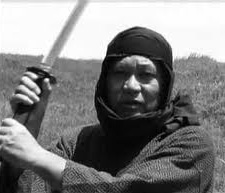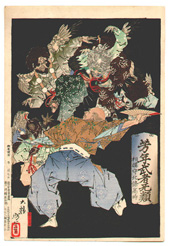Plans for 2013
The next session of classes will begin on Monday, September 23rd for Classical Jujutsu, and Wednesday, September 25th for Kenjutsu.
There are a lot of things coming up:
Togakure Ryu Ninja Biken (for Kenjutsu on Wednesdays)
 The sword tradition of Togakure Ryu is called Ninja Biken; while this name can translate as "secret ninja sword technique", it misdirects more than it reveals. While this is appropriate, in reality this sword school uses a blend of orthodox and unorthodox uses for the sword. The Ninja Biken is one of the original two kenjutsu styles Manaka Unsui Sensei learned in his youth. In fact, Unsui Sensei attained menkyo kaiden - a certificate of complete transmission - from his teacher in Togakure Ryu. He would later draw on its influences when creating his own style, Jinen Ryu Kenjutsu. The sword tradition of Togakure Ryu is called Ninja Biken; while this name can translate as "secret ninja sword technique", it misdirects more than it reveals. While this is appropriate, in reality this sword school uses a blend of orthodox and unorthodox uses for the sword. The Ninja Biken is one of the original two kenjutsu styles Manaka Unsui Sensei learned in his youth. In fact, Unsui Sensei attained menkyo kaiden - a certificate of complete transmission - from his teacher in Togakure Ryu. He would later draw on its influences when creating his own style, Jinen Ryu Kenjutsu.
The Togakure Ryu sword, unlike the popular conception of a ninja-to, features a curved edge, not a straight blade. Seen when sheathed, in fact, it would seem perfectly ordinary. This was its goal: to not draw attention by an unusual appearance. Nor was it worn on the back, projecting above the shoulder; it should sit within the warrior's obi (sash or belt). When it was appropriate to wear a sword, the bearer would do so the same as any member of the bushi class. However, the sword was typically shorter than the saya (scabbard): this allowed for a faster draw, clearing the saya before an opponent expected. Furthermore, it was more maneuverable, and appropriate to use indoors. Further, the scabbard could also house special characteristics, such as space for metsubushi (blinding powders) or hidden messages.
The kata themselves, while not divided into separate scrolls, fall into two broad categories: orthodox and unorthodox techniques. The orthodox techniques are, quite simply, Kenjutsu kata as we might expect to see in other styles. They make use of the sword's unique characteristics, but still depend on maai (distance/timing), speed, and powerful cutting. After all, each sword ryu-ha would prefer, and capitalize on the use of, the particular shape and size of their sword. The unorthodox techniques, on the other hand, make use of deception, misdirection, and surprise. They also require an ability to see the whole environment and manipulate it to advantage. Of course, once an unorthodox tactic is deployed, the opponent will be aware of it and no longer fooled, if the tactic was not followed up on immediately and decisively. But these kata are, more significantly, training for thinking in a manner your opponent will not.
The kata also reveal that Togakure Ryu Ninja Biken is not an assassin's sword style. The character of the kata does not match the popular misconception of the ninja as black-clad killer. Both the short, unobtrusive sword itself and the knowledge to use it - embedded in the kata - are multi-purpose tools permitting a spy to conduct espionage, collect intelligence, and successfully return from behind enemy lines, with that larger goal being more important.
Martial Arts Lecture and Demonstration at Camellia Teas: Sat., Sept. 28th, 1-3PM
 At the gracious invitation of Camellia Teas, Dojo-Cho Andy Keyworth will deliver a history lecture on the "History of the Warrior in Feudal Japan". A demonstration of some of the martial arts made famous by the warrior class will follow in the garden (with modification possibly necessary due to weather). Camellia Teas is a beautiful setting for an exploration of this aspect of Japanese history. At the gracious invitation of Camellia Teas, Dojo-Cho Andy Keyworth will deliver a history lecture on the "History of the Warrior in Feudal Japan". A demonstration of some of the martial arts made famous by the warrior class will follow in the garden (with modification possibly necessary due to weather). Camellia Teas is a beautiful setting for an exploration of this aspect of Japanese history.
The warrior class of feudal Japan was more than a Samurai movie stereotype. It was an adaptive response to the pressures facing a dynamic, sometimes turbulent, young nation.
These warriors - known also as "Bushi" - trained and shaped themselves for war; at the same time, they nurtured Japanese arts, crafts, learning and culture. We offer a look at the rise, influence and fate of the Japanese classical warrior class.
The cost of the workshop will be $20. Please contact Camellia Teas to register, at: info@camelliateas.net. To download a JPG copy of the poster, click here.
Gyokko Ryu Kosshijutsu: Henka Waza Shutai (for Classical Jujutsu on Mondays)
 After completing our examination of the Gyokko Ryu Kosshijutsu kata last year, we are following up with the Henka Waza Shutai- the "focus on variations". This is official Jinenkan training material, meant to expand on and deepen our understanding of the original kata. After completing our examination of the Gyokko Ryu Kosshijutsu kata last year, we are following up with the Henka Waza Shutai- the "focus on variations". This is official Jinenkan training material, meant to expand on and deepen our understanding of the original kata.
Henka - essentially, the ability to change from the original form of a kata as the need arises - is a much misunderstood form of training. Too often, martial artists demonstrate henka when their training partner has not given them any reason to. This can lead to a false sense of mastery: when the uke (partner representing the opponent) only does the same rote movements, but tori (partner practicising the technique) may move freely, then there is no real sense of resistance. This is the illusion that "I can do whatever I want to my opponent". The potential danger is obvious.
The Jinenkan emphasizes henka based on first mastering the essential kata, then responding when the opponent resists. Not only is this reasonable to expect from an opponent, but it also provides critical feedback on when to change and react. By sensing the resistance, tori learns to either change his technique to another, or to simply switch where he is attacking. This sudden change is hard for an opponent to adapt his resistance to, and will more likely succeed. Unsui Sensei discussed this as dual meanings of gaman- perserverance. The uke shows gaman by resisting the initial technique; tori shows gaman by responding instantly without freezing up.
Military Combatives / Self-Defence workshop with Cris Anderson: Saturday, Oct. 26th
The Jinenkan Ottawa Dojo will host a new workshop by returning Military Combatives instructor Cris Anderson. Our previous sessions have been very successful. The format of this workshop will be somewhat different from what returning participants have experienced.
After several workshops focusing on straight-forward, simple self-defence, Cris will prepare something special for us this time. We're going back in history, to focus explicitly on one of the systems of World War II Combatives which is his specialty.
The workshop will be at the Heron Road Community Centre, on Saturday, Oct. 26th. The cost is $20. This will be a City of Ottawa program.
You can register online at www.ottawa.ca, or in person at any City of Ottawa recreation facility. Please call the Heron Road Community Centre at 613-247-4808 for more information about registration.
For this workshop, you will only need to dress in pants with no snaps, buttons or zipper, please. T-shirt or sweat shirt is fine. Bring your water bottle and notebook.
For more information about the workshop, email andy@jinenkan-ottawa.com or call 613-263-0441.
|